Not Just Neural Networks: The Wide Reach of One Prof’s Teaching and Research
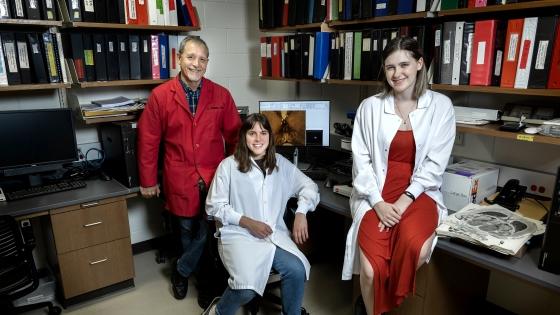
Undergraduate students participate in graduate-level research in Prof. Julio Ramirez’ neuroscience lab. Many former students continue to collaborate on research with Ramirez and keep in touch to share their personal and professional accomplishments. Ramirez is pictured with students Emma Jones '23 (l) and Corryn McAfee '24 (r).
Growing up in low-income housing in Bridgeport, Connecticut, Julio Ramirez didn’t know people who went to college or worked in research labs.
That he would become an internationally renowned professor of neuroscience at Davidson College is a credit to his mother, a Cuban immigrant who worked all her life on factory assembly lines.
Elia Cortés scrimped to send her son and daughter, Ely, eight years older, to Catholic elementary school. Even as a child, Ramirez understood the sacrifice.
“My mom was doing her job,” he said. “And I had a job to do, too.”
After school, he would let himself into their apartment at Evergreen Garden. (He remembers it was “never green” and there was “no garden”). He’d watch some TV and dutifully do his homework.
On Saturdays, she walked her son to the public library to check out science books his school didn’t have. And she subscribed to a magazine that fed his fascination with the space program.
“Some kids were learning about baseball players,” Ramirez said. “I was learning about astronauts.”
He loved the subject so much he asked his eighth-grade teacher, Sister Mary Norbert, to let him lead lessons about “man in space” missions, from Mercury to Apollo.
You might say that launched his career.
With scholarships, part-time jobs, and a used Ford Pinto, Ramirez commuted to nearby Fairfield University, a private liberal arts college. On that beautiful, leafy campus, he fell more deeply in love with science—especially “how the mind works”—and decided he wanted to get a job “at a place like this.”
Nine years later, in 1986, that dream came true when Ramirez was hired at Davidson as assistant professor of psychology. By that time, he had finished graduate school and post-doctoral work and was an emerging expert in physiological psychology, now known as neuroscience.
Over the years, his students became experts too. Side-by-side with Ramirez, they ran experiments on laboratory rats and proved the once-controversial idea that brains damaged by trauma or disease could regenerate and recover memory.
This process, called neuroplasticity, was not widely accepted until the 1990s. By then, Ramirez and his students were regularly publishing articles in top neuroscience journals, describing findings in rats that might offer new insights into human problems, such as Alzheimer’s disease. Their unusual accomplishments garnered national notice.
Four of their articles were significant enough to earn citations in Biological Psychology, a textbook used in college classrooms around the world.
“I don’t know of another example of somebody at a four-year college who has done research of this quality over such an extended period of time,” said James Kalat, the textbook’s author and emeritus professor of psychology at N.C. State University in Raleigh.
Defying Expectations
Ramirez, 67, now the R. Stuart Dickson Professor of Psychology, has repeatedly defied expectations not only with his published findings, but by teaching undergraduates to do meaningful research at a college without graduate programs.
“It’s unusual for this to be happening at Davidson,” said Oswald Steward, president of the Society for Neuroscience and director of the Reeve-Irvine Research Center at the University of California Irvine.
“I’ve had more than one of his students come and work in my lab,” Steward said. “And I really appreciate the high level of training they got before they ever came to graduate school. Their thinking was just very, very advanced.”
For his accomplishments, Ramirez has received prestigious honors—from national and international science organizations and from former President Barack Obama.
The Association for Psychological Science (APS) recently announced Ramirez will receive a 2024 lifetime achievement award—the APS Mentor Award—for his distinguished teaching record and impact on students. The international organization is dedicated to advancing scientific psychology across disciplinary and geographic borders.
Thanks to Ramirez’ reputation, Davidson’s neuroscience program attracts many students who could have gone to Ivy League schools.
Even Time magazine took notice in 2006, featuring James Sanchez ’07 in a cover story headlined, “Who Needs Harvard?”
Sanchez was accepted into Harvard, Dartmouth, Duke and Rice universities. He turned them all down to attend Davidson, “lured by the promise of working with actual professors instead of graduate students who often teach at many big-name universities.”
Now an ophthalmologist in Santa Fe, Sanchez said his work in Ramirez’ lab gave him a boost when applying to medical schools. He ended up with a full scholarship to Washington University in St. Louis.
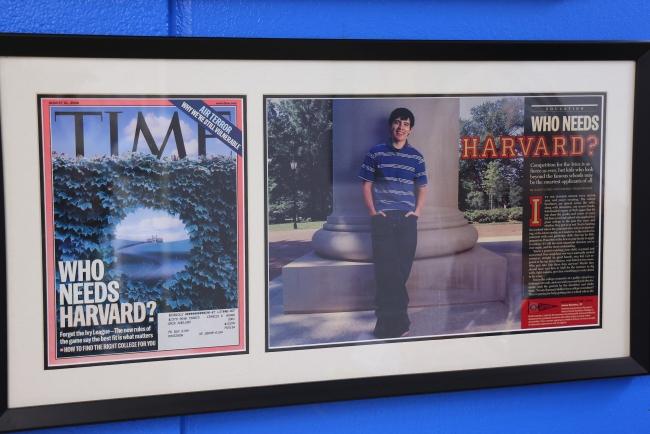
A Time magazine cover story featuring James Sanchez ’07 hangs on the wall in Ramirez’ laboratory.
Matthew De Niear ’11 tells a similar story. While in high school in New Jersey, he began looking at neuroscience programs in the Northeast. “A lot of people, especially at liberal arts schools, would mention Dr. Ramirez and ask, ‘Have you checked out Davidson?’ That was a pretty good endorsement.”
After Davidson, De Niear earned medical and doctoral degrees from Vanderbilt University. He specialized in ophthalmology because of the proficiency he developed doing microscopic surgery on rats.
“Almost all ophthalmic surgery is done under a microscope. It prepared me well,” De Niear said. “It’s really kind of amazing that we produced such high-level research. The glue to that is Dr. R.”
De Niear did his residency at the University of California at Davis and is now in his first year of private practice in the San Francisco Bay area. Although he and his wife, the former Grace Fletcher ’11, had left North Carolina, they held their wedding at the college’s Lake Campus in 2017. They invited Ramirez, who keeps a photo of himself with the newlyweds on a shelf in his office.
“It’s such a special place for both of us,” said De Niear. He and his wife now have two young children.
Becoming an Example
When Ramirez came to Davidson for an interview in spring 1986, he was smitten. Dogwoods and azaleas bloomed under warm, sunny skies. Quite a contrast to the cold and gray weather around Boston, where he was finishing post-doc work at the Massachusetts Institute of Technology.
On his second day, he woke up at the campus Guest House and stuck his head out the window.
“It was every bit as beautiful as the day before. I couldn’t believe it,” he said. “A couple days later, I got the job offer, and I haven’t looked back since.”
He quickly became a fixture on campus, wearing a ponytail, a droopy mustache, blue jeans, and leather fanny pack. He’s since lost the ponytail and cut back the mustache, but still wears a fanny pack, for which he endures endless teasing.
In his early years at Davidson, Ramirez would adopt the persona of “Rat Man”—an homage to his lab rats—to emcee a sock hop to raise money for a local charity.
“He’s always been a funny, bigger-than-life character on campus,” said Political Science Professor Ken Menkhaus, who arrived at Davidson a few years later.
They quickly became friends, sharing their love of current events, teaching and, eventually, their growing families.
“He was always one stage ahead of me,” Menkhaus said. “When he was talking about real estate, I was still talking about dating. When he was talking about kids, I was talking about real estate.”
Ramirez met his wife, Annie Porges ’85, when she was assistant director of Alumni Relations. They started dating after a Halloween party hosted by Menkhaus. Ramirez thought Porges was “pretty clever” to come dressed as a “Freudian Slip,” wearing a black slip dress pinned with phrases such as “Oedipus complex” and “Super Ego.”
They married in 1994 and had two children. Elia, 26, is a 2019 Davidson graduate studying for a doctoral degree in educational psychology at the University of Virginia. Julian, 24, is a 2021 graduate of Washington and Lee University and is working as an ice climbing and glacier guide in Alaska.
Porges, now senior major gifts officer for Davidson’s College Relations division, continues to be amazed by the deep relationships her husband develops with his students and how much he cares about his work.
“I would never have taken his class, not for a million years,” she said. “But he loves what he does. It lights up his brain.”
Ramirez helped change campus culture, Menkhaus said. “He came in, this young charismatic Latino with long hair. He didn’t fit the conventional mold of a Davidson professor in the 1980s. And that was wonderful. That freed up the rest of us to say, we can be whoever we want.”
Menkhaus, an expert on the Horn of Africa whose research has taken him into war zones, admired how Ramirez involved students in his lab.
One of Julio’s biggest impacts at Davidson has been the example he’s set to incoming faculty that this is what you can aspire to in terms of bringing students into your work. He expanded our imagination.
Mentorship
Of the many honors Ramirez has garnered, two are displayed most prominently in his corner office of the E. Craig Wall Jr. Academic Center.
One is the 2009 Presidential Award for Excellence in Science, Mathematics and Engineering Mentoring. It hangs next to a photo of Ramirez shaking hands with then-President Obama in the Oval Office.
The other is the 2012 Hunter-Hamilton Love of Teaching award, announced annually at Davidson’s commencement. It’s special because the nominations came from Ramirez’ students, and the judges were faculty peers.
These awards recognizing “mentorship” give Ramirez ironic satisfaction—because he encountered resistance early on for the audacity of his approach.
Back then, the prevailing attitude was that “you teach by walking into a classroom, and you pontificate,” he said. “You have students do pre-packaged experiments. But there was a group of us who were arguing, no, we need to rethink how we educate our young scientists.”
Ramirez believed undergraduates at a small liberal arts college could do the kind of meaningful research usually reserved for graduate students at major universities.
But when he applied for all-important research grants, he sometimes got rejected. “They didn’t really believe we could do it here, because it was a small place.”
Over time, he proved them wrong.
In 37 years at Davidson, Ramirez has been awarded millions of dollars in research and mentoring grants. He has mentored more than 150 students in what they lovingly call the “Ramirez Rat Lab.” Many have gone on to work at top-tier institutions, such as Harvard University and the National Institutes of Health.
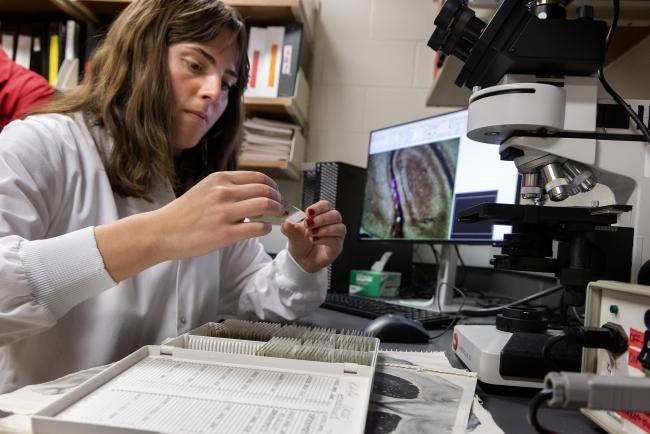
A recent study published in Neurobiology of Learning and Memory lists eight authors—seven former students and Ramirez.
“When you walk into his lab, there are undergraduates doing NIH-sponsored experiments,” said Joseph Taylor ’06, now a faculty psychiatrist at Harvard. “He trains them so well they have the skills and the confidence to do this with very little oversight. It’s remarkable.”
Ramirez puts senior students in charge of the lab. They teach younger students to perform microsurgery on the brains of rats and run them through mazes to observe the effect on behavior and memory. Students also implant electrodes in rat brains and document electrical activity to show how brain cells communicate.
Along with autonomy, Ramirez gives his students credit.
That’s why the latest journal article, published early this year by the journal Neurobiology of Learning and Memory, lists eight authors. The first seven are former students, including De Niear. All have doctoral, medical or combined doctoral and medical degrees.
Ramirez’ name is last.
“If they write it, they get first authorship,” he said. “I try to help the students exceed what they view as their own limits. I want to help them do more than they think they can.”
The Research
Even as an undergraduate at Fairfield, Ramirez liked to “press the envelope.” He wrote a paper casting doubt on the prevailing attitude that a damaged brain could never recover. If other organs can, he thought, why not the brain?
After graduation in 1977, he chose Clark University in Massachusetts for graduate school, to work with Professor Donald Stein, an “iconoclast” and early proponent of neuroplasticity.
“Don really gave us a lot of leeway,” said Ramirez, whose first project was to try to replicate the groundbreaking work by Steward, one of the first to document neuroplasticity in 1973.
When Ramirez couldn’t get the experiment to work, he contacted Steward, and they identified the problem. They’ve been friends ever since.
“It was a subtle change, but it made a huge difference,” Ramirez said. “That speaks to why it’s so important that scientists talk to one another.”
At Davidson, Ramirez and his students have continued research on neuroplasticity with a particular focus on memory centers of the brain.
They showed how one of the pathways associated with memory, the entorhinal cortex, responds to damage by sprouting new connections to the hippocampus, the main memory center.
“The sprouting is propping up the brain while cells are dying,” Ramirez said. “What it’s basically doing is plugging the leaks and trying to keep the boat afloat.”
He and his students also showed they could speed up that sprouting process—and the recovery of memory—by making two lesions in a rat’s brain, a week apart. That primed cells to grow faster.
Next, they found that a second pathway that affects memory—the septum—also sprouts functional connections when the brain is damaged. That led to the recent journal article which explained that both the septum and the entorhinal cortex sprout connections that communicate with each other and with the hippocampus.
Ramirez and his students are the first to demonstrate that “those two sections can combine their influences to promote recovery,” said Kalat, the textbook author. He said he’ll add a citation to this work in his next edition.
In recent years, autopsies of the brains of Alzheimer’s patients have shown the same kind of sprouting that Ramirez and his students have seen in rats. While it takes years for animal research to lead to human studies, they hope their findings will one day lead to new treatments for Alzheimer’s disease.
Steward praised Ramirez and “his great group of students at Davidson” for “careful follow-up research” that has systematically expanded the understanding of brain pathways of rats and, potentially, of Alzheimer’s patients.
“This is a great paper,” he said. “It gives us a window into the likely changes that are going on as this pathway degenerates over time. … This pathway is so important in Alzheimer’s disease, and in memory.”
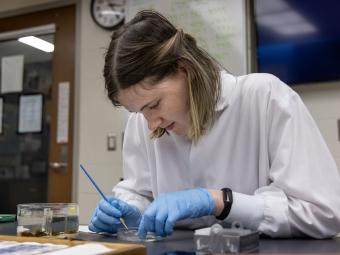
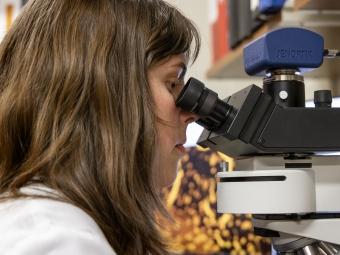
Overlapping Circles
As the 2022-23 school year came to a close, Ramirez proudly sent off two more neuroscience students—Emma Jones and Jordan Benson—to “plum jobs” at Harvard.
Jones, of Winston-Salem, will be a research assistant for fellow Davidson alum, Taylor, the Harvard psychiatrist who is director of clinical trials at the school’s Center for Brain Circuit Therapeutics.
Taylor said hiring Jones was “essentially a no-brainer…If Julio is endorsing you, there’s probably not much more vetting that needs to take place.”
These post-Davidson connections keep multiplying.
Not long ago, Taylor told Ramirez he touched base with another Davidson neuroscience grad at Harvard, Erik Knelson ’07.
Knelson went to Duke for medical and doctoral degrees, then to Harvard for residency and fellowship in oncology before joining the Harvard medical school faculty. Although he and Taylor had been at Harvard for several years, they hadn’t crossed paths until they made time to meet for coffee.
Knelson’s name came up again in a story involving Martina Mustroph ’08, a neurosurgery resident at Harvard. Mustroph told Ramirez she was called one day to consult on a cancer patient. It turned out the patient’s doctor was Knelson.
“I vaguely knew that Erik was in Boston, but we’re all busy people,” Mustroph said. “We both stay in touch with Dr. Ramirez and have benefited from his incredible mentorship throughout our careers.”
Ramirez delights in these stories.
“There are overlapping circles all the time now. That’s one of the best parts of the job. I get to have the fun of being surrounded by these amazing young people,” he said. “It’s awesome to see what happens with them all.”
This article was also published in the Fall/Winter 2023 print issue of the Davidson Journal Magazine; for more, please see the Davidson Journal section of our website.
Published
- June 14, 2023
Category
Author
- Karen Garloch